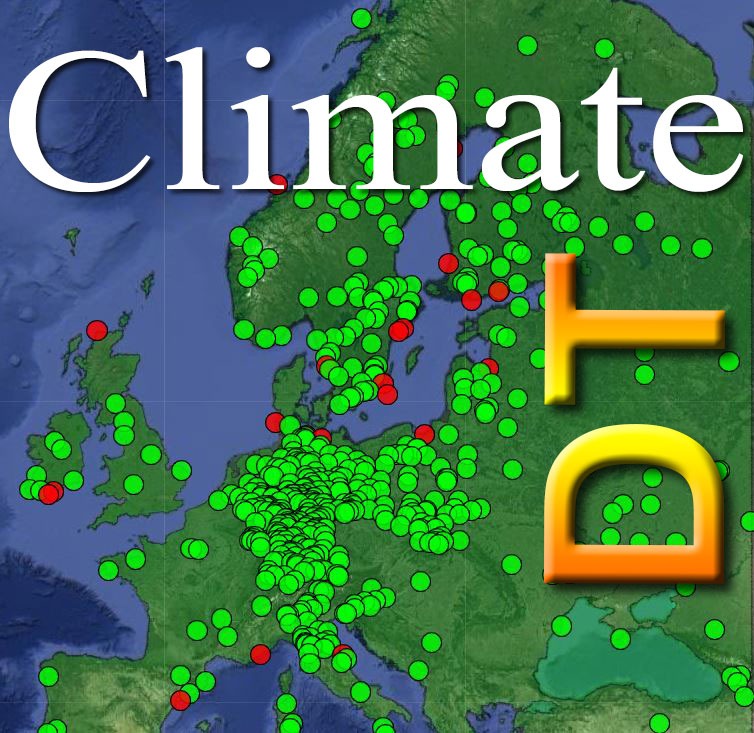
ClimateDT Description
1. Why using ClimateDT?
Interpolated climate data have become an essential tool for researchers across many disciplines. Long-term climate baseline data with appropriate spatial and temporal resolution are required, though such data are not readily available in consistent formats and with an appropriate spatial resolution. This is the reason why downscaling techniques have been developed and why ClimateDT has been implemented.
2. Rationale
Climate-DT can be used for downscaling a large variety of raw climatic data and indices between 1901 and 2098. This tool incorporates three different sources of climatic data: a baseline high resolution grid for the period 1961-1990, a dataset of monthly anomalies for the historical period derived from CRU-TS and future scenarios from UKCP18 surfaces ([1], [2]). Input data are spatial coordinates and elevation which will be used for the scale-free statistical downscaling procedure.
3. Scientific Background
3.1 Climatic baseline – CHELSA 1.2
A baseline climatic normal period is often used as an important starting period for biological and ecological studies. Among all the possible datasets, the 1961-1990 is acknowledged as a pre-industrial period ([3], [4], [5]) as well as one of these whose raw data from meteorological stations are more abundant ([6], [7]). However when dealing with climate data, the baseline selection must be driven by data quality. In ClimateDT the period 1979-2013 has been used as the central normal period for downscaling. This period is the native normal period of CHELSA 1.2 dataset ([7]) which we selected as the best surface to be used since its global coverage and high-level reputation in scientific framework. This normal period is where the scale-free dynamic downscaling occurs and where anomalies from CRU-TS and UKCP18 are placed on.
3.2 Historical Climatic Data Sets – CRU time series
CRU-TS ([2]) is likely the most referenced and well-known global database for raw climatic data (temperature and precipitation) with a spatial resolution of approximately 50 km at the equator. The dataset is updated regularly and the most recent version is here used (1901-current). In ClimateDT this dataset is used to generate the historical climate. Anomalies are derived from the 1961-1990 baseline period and stored in single GeoTiff files in our system. Since the effect of elevation and terrain features in general on anomalies can be neglected during the downscaling process ([8]), these are added to the dynamically-downscaled data using a bilinear interpolation only on target locations which are requested by users.
3.3 Future Climatic Data Sets – UKCP18 projections
UKCP18 is a large set of climatic surfaces and uses cutting-edge climate science to provide updated observations and climate change projections out to 2100 in the UK and globally. The project builds upon UKCP09 to provide the most up-to-date assessment of how the climate of the UK may change over the 21st century. In Climate-DT this database has been mounted on the 1961-1990 climatic normal period in the same way as CRU-TS, using the anomalies approach. Actually the climate change forcing (anomaly) was calculated from the common normal period (i.e., 1961-1990) and added the baseline using bilinear interpolation. This procedure also removes the intrinsic difference between the two datasets and to generate a unique and robust time series between 1901 an 2098.
3.4 Downscaling procedure and algorithms
The core of the ClimateDT system is the spatial interpolation of climatic data with a dynamic lapse rate adjustment to be applied to each submitted location separately. This method is currently implemented in some standalone softwares such as ClimateNA for north America ([9]), ClimateAP for Asia ([10]) and ClimateEU for Europe ([6]). The main step of the dynamic lapse rate adjustment is an evaluation of the relationships between variability of climatic parameters (i.e. temperature or precipitation) and elevation in the surrounding of the location where climatic data needs to be downscaled to. To achieve this, after the geographic interpolation (i.e. DEM-independent) using the bilinear or other processes such as IDW (also available here), climatic and elevation data are firstly extracted from the 8 pixels surrounding the pixel where the spatial location is located plus the pixel itself (9 in total). All possible differences between the 9 climate variables (∆c) are calculated, obtaining a set of 36 unique pairs of differences. The same procedure is replicated for elevation (∆e), then a simple linear regression is built, based on the 36 pairs to reflect the local relationship between ∆c and ∆e. The slope of the regression line m represents the local (i.e. dynamic) lapse rate for the point of interest (i.e. the cell where the point of interest is located):
Since elevation is a required information for the portal, this data can be used to calculate the difference between the reference elevation of the system (i.e. the WorldClim DEM available here) and the “real” elevation of the locations(s) the user has requested. This delta is used for the dynamic lapse rate adjustment to be applied to the climactic value interpolated before. Actually the difference between actual elevation of the location and the spatially-interpolated elevation of the point of interest is used in the equation and summed to the spatially-interpolated value as:
where SPTc is the spatial interpolation of climatic variable, i and m are the intercept and the slope (lapse rate) of the regression (1) respectively, SPTe is the elevation the system calculates from the 1 km Digital Elevation Model and Elev is the elevation provided by the user in the submitted file.
The procedure here described is the downscaling process applied to the 1961-1990 baseline period only and for the three main climatic parameters: monthly minimum temperatures, monthly maximum temperatures and monthly precipitations. Then anomalies are spatially downacaled and summed (or subtracted according to the sign of the numbers) to these baseline to obtain the full time series between 1901 and 2098. After the downscaling process is completed, the calculation of climatic indices is performed.
4. Description of the output
The system currently outputs three monthly variables (minimum temperature, maximum temperature and precipitation) plus 39 climatic variables and indices (annual or monthly) over the whole time period (1901-2098). However shorter period can be requested. Among these parameters, the raw climatic variables with monthly resolution, the 19 bioclimatic parameters from the WorldClim portal using the dismo package ([11]), SPEI and SPI indices with the SPEI package ([12]) and other drought and frost indices also available in literature and widely used in ClimateNA, CliamteAP and ClimateEU systems ([9], [10]). The full list of output variables is available here.
5. System performance
ClimateDT currently employs 3 CPUs on a virtual machine hosted at CNR-IBBR in Florence (Italy). The system currently needs approximately 10 minutes to process 512 locations for the full time coverage (1901-2098) and for all the indices. The calculation is currently limited to 512 locations. However, more than one submission is allowed, each including a maximum of 512 locations. The whole calculation is performed in R environment and implements additional R packages which are still under development.
6. Future Releases
ClimateDT is an open-source system and it is under continuous development and updating. New indices, interpolation methods, base datasets and tools are planned to be added to the systems soon. Any feedback from users is welcome. New requests can be sent to the staff in order to implement new indices currently missing in the output files.
7. References
- Lowe JA, Bernie D, Bett PE, Bricheno LM, Brown SC, Calvert D, Clark R, Eagle K, Edwards T, Fosser G, Maisey P, McInnes RN, Mcsweeney C, Yamazaki K, Belcher S (2019). UKCP 18 Science Overview Report (version 2.0). November 2018 (Updated March 2019). Met Office Hadley Centre, Exeter, UK.
URL: https://www.semanticscholar.org/paper/UKCP-18 - Harris I, Osborn TJ, Jones P, Lister D (2020). Version 4 of the CRU TS monthly high-resolution gridded multivariate climate dataset. Scientific Data 7: 109.
doi: https://doi.org/10.1038/s41597-020-0453-3 - Mbogga MS, Hamann A, Wang T (2009). Historical and projected climate data for natural resource management in western Canada. Agricultural and Forest Meteorology 149 (5): 881-890.
doi: https://doi.org/10.1016/j.agrformet.2008.11.009 - Ray D, Petr M, Mullet M, Bathgate S, Marchi M, Beauchamp K (2019). A simulation-based approach to assess forest policy options under biotic and abiotic climate change impacts: A case study on Scotland's National Forest Estate. Forest Policy and Economics 103: 17-27.
doi: https://doi.org/10.1016/j.forpol.2017.10.010 - Isaac-Renton MG, Roberts DR, Hamann A, Spiecker H (2014). Douglas-fir plantations in Europe: A retrospective test of assisted migration to address climate change. Global Change Biology 20: 2607-2617.
doi: https://doi.org/10.1111/gcb.12604 - Marchi M, Castellanos-Acuña D, Hamann A, Wang T, Ray D, Menzel A (2020). ClimateEU, scale-free climate normals, historical time series, and future projections for Europe. Scientific Data 7: 428.
doi: https://doi.org/10.1038/s41597-020-00763-0 - Karger DN, Conrad O, Böhner J, Kawohl T, Kreft H, Soria-Auza RW, Zimmermann NE, Linder HP, Kessler M (2017). Climatologies at high resolution for the earth’s land surface areas. Scientific Data 4: 1–20.
doi: https://doi.org/10.1038/sdata.2017.122 - Wang T, Hamann A, Spittlehouse D, Aitken SN (2006). Development of scale-free climate data for western Canada for use in resource management. International Journal of Climatology 26: 383-397.
doi: https://doi.org/10.1002/joc.1247 - Wang T, Hamann A, Spittlehouse D, Carroll C (2016). Locally downscaled and spatially customizable climate data for historical and future periods for North America. PLoS One 11: e0156720.
doi: https://doi.org/10.1371/journal.pone.0156720 - Wang T, Wang G, Innes JL, Seely B, Chen B (2017). ClimateAP: An application for dynamic local downscaling of historical and future climate data in Asia Pacific. Frontiers in Agricultural Science and Engineering 4: 448–458.
doi: https://doi.org/10.15302/J-FASE-2017172 - Hijmans RJ, Phillips S, Leathwick J, Elith J (2015). dismo: Species Distribution Modeling. R package version, 1.1-4.
URL: https://cran.r-project.org/web/packages/dismo/dismo.pdf - Maca P, Pech P (2016). Forecasting SPEI and SPI Drought Indices Using the Integrated Artificial Neural Networks. Computational Intelligence and Neuroscience 2016: 1–17.
doi: https://doi.org/10.1155/2016/3868519
